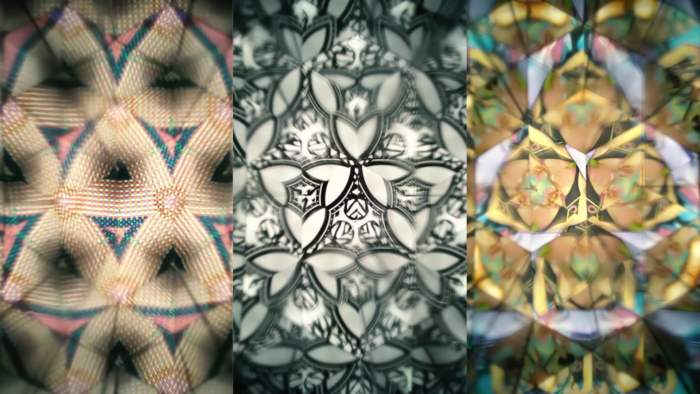Repeated Reflection: Kate Lahey on Main Gallery exhibition Three Way Mirror
Essay available in LARGE FONT
Repeated Reflection
by Kate Lahey

The three-way mirror is a therapeutic heuristic that enables the subject to integrate traumatic experience with self by exploring three orientations towards the event: our past, the event and the accumulation of our life experiences. This model, conceptualized by trauma theorists Gusman, et al¹, attempts to make space for the nuance and multiplicity of identity, especially culturally, in trauma therapy. Not only does this model attempt to integrate different orientations toward a traumatic event for therapeutic purposes, it also invokes three points of view by engaging “the experiential self, the observing self, and the new integrated self” (pp. 448). By moving between and across different perspectives and orientations, the three-way mirror attempts to integrate representations of self with trauma to achieve reparative unity. Indeed, trauma fractures. Our sense of self, time, memory, and many other things may be shattered by traumatic injury. The wounded psyche returns us to the moment of injury in repetitive waves, haunting us through flashbacks and dreams, dwelling in the body and lacing our relationship to ourselves, each other and the world around us. Healing such wounds can be equally fractious, incongruent and non-linear.
One such place we enact healing is by making anew. Aesthetics can offer us opportunities to make meaning from the incongruous detritus of violence. Beauty, of course, may not always feel urgent, but it is necessary. The title of this work, “Three Way Mirror”, invokes aesthetic references such as the triptych and the kaleidoscope. The latter means to observe beautiful forms. Engaging with paper crafts, glass, and toy making, the kaleidoscope is an object that evokes the intersections of distortion and beauty. Viewing through a moving cylinder, the three or more pieces of reflective glass distort images, often colourful paper, in order to create hypnotic, almost hallucinogenic spectacles in the palm of one’s hand. Affordable and playful, the kaleidoscope engages colour, shape and movement to create joy. A common children’s toy, the kaleidoscope makes the ordinary extraordinary. Far from infantile, such repetitions not only inspire joy, they might create room for connection, shared witnessing and laughter.
Barrow, Gratland and Gear engage with objects, reflections, repetitions and refractions through their collective work. Like the joyful, colourful, and moving aesthetics that kaleidoscopes and mirrors evoke, the artists use material traditions of craft-making in order to explore the ways in which our relationships can create space for connection, reflection and healing. Working across forms, cultural identities and regions, Barrow, Gratland and Gear find ways to explore shared experience while honouring the ways in which difference contours their praxis. Their queer craft triangle allows for individual praxis to be refracted through the prism of collaboration while enforcing the possibilities that collectivity might pronounce: joy, witnessing, reflection and repair. “Three Way Mirror” calls upon the colourful play of the kaleidoscope in a celebration of queer sensibilities through both distortion and the decorative. Both video and adornable objects explore somatic expressions of both shame and pleasure. Working with thematic tensions, such as the individual and the collective, past and future, memory and material, Barrow, Gratland and Gear invite queer theories and methods into this body of work.
¹ Gusman, F. D., Stewart, J., Young, B. H., Riney, S. J., Abueg, F. R., & Blake, D. D. (1996). A multicultural developmental approach for treating trauma. In A. J. Marsella, M. J. Friedman, E. T. Gerrity, & R. M. Scurfield (Eds.), Ethnocultural aspects of posttraumatic stress disorder: Issues, research, and clinical applications (pp. 439–457). American Psychological Association. https://doi.org/10.1037/10555-017
 Kate Lahey is a writer, musician and PhD candidate at the Women and Gender Studies Institute, University of Toronto. As frontperson of Weary, Kate recently released their sophomore album ‘Hush’. Kate is also a course instructor at the Gender Studies Department at Memorial University of Newfoundland. Kate’s work explores intergenerational trauma, material and visual culture and memory in Newfoundland. As a Newfoundlander, Kate’s practice engages family knowledge. Kate lives in a two hundred year old salt box house on the Atlantic Ocean in Holyrood, Newfoundland with her partner and aussie shepherd Leia.
Kate Lahey is a writer, musician and PhD candidate at the Women and Gender Studies Institute, University of Toronto. As frontperson of Weary, Kate recently released their sophomore album ‘Hush’. Kate is also a course instructor at the Gender Studies Department at Memorial University of Newfoundland. Kate’s work explores intergenerational trauma, material and visual culture and memory in Newfoundland. As a Newfoundlander, Kate’s practice engages family knowledge. Kate lives in a two hundred year old salt box house on the Atlantic Ocean in Holyrood, Newfoundland with her partner and aussie shepherd Leia.